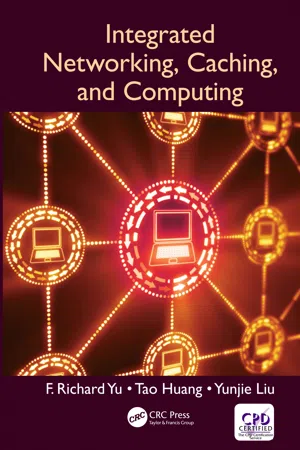
This is a test
- 240 pages
- English
- ePUB (mobile friendly)
- Available on iOS & Android
eBook - ePub
Integrated Networking, Caching, and Computing
Book details
Book preview
Table of contents
Citations
About This Book
This book features the major research advances on integrated networking, caching, and computing. Information-centric networking-based caching is one of the promising techniques for future networks. The cloud computing paradigm has been widely adopted to enable convenient, on-demand network access to a shared pool of configurable computing resources. In addition, fog/edge computing is proposed to deploy computing resources closer to end devices. From the perspective of applications, network, cache and compute are underlying enabling resources. How to manage, control and optimize these resources can have significant impacts on application performance.
Frequently asked questions
At the moment all of our mobile-responsive ePub books are available to download via the app. Most of our PDFs are also available to download and we're working on making the final remaining ones downloadable now. Learn more here.
Both plans give you full access to the library and all of Perlego’s features. The only differences are the price and subscription period: With the annual plan you’ll save around 30% compared to 12 months on the monthly plan.
We are an online textbook subscription service, where you can get access to an entire online library for less than the price of a single book per month. With over 1 million books across 1000+ topics, we’ve got you covered! Learn more here.
Look out for the read-aloud symbol on your next book to see if you can listen to it. The read-aloud tool reads text aloud for you, highlighting the text as it is being read. You can pause it, speed it up and slow it down. Learn more here.
Yes, you can access Integrated Networking, Caching, and Computing by F. Richard Yu, Tao Huang, Yunjie Liu in PDF and/or ePUB format, as well as other popular books in Computer Science & Information Technology. We have over one million books available in our catalogue for you to explore.
Information
Contents
1 Overview, Motivations and Frameworks
1.1 Overview
1.1.1 Recent advances in wireless networking
1.1.2 Caching
1.1.3 Computing
1.2 Motivations and requirements
1.2.1 What is integration of networking, caching and computing?
1.2.2 Why do we need integration of networking, caching and computing?
1.2.2.1 The growth of networking alone is not sustainable
1.2.2.2 The benefits brought by the integration of networking, caching and computing
1.2.3 The requirements of integration of networking, caching and computing
1.2.3.1 Coexistence
1.2.3.2 Flexibility
1.2.3.3 Manageability and programmability
1.2.3.4 Heterogeneity
1.2.3.5 Scalability
1.2.3.6 Stability and convergence
1.2.3.7 Mobility
1.2.3.8 Backward compatibility
1.3 Frameworks
1.3.1 Caching‐networking framework
1.3.1.1 D2D delivery (Fig. 1.2a)
1.3.1.2 Multihop delivery via D2D relay (Fig. 1.2b)
1.3.1.3 Cooperative D2D delivery (Fig. 1.2c)
1.3.1.4 Direct SBS delivery (Fig. 1.2d)
1.3.1.5 Cooperative SBS delivery (Fig. 1.2e)
1.3.2 Computing‐networking framework
1.3.2.1 Cloud mobile media
1.3.2.2 Mobile edge computing
1.3.3 Caching‐computing framework
1.3.4 Caching‐computing‐networking framework
1.3.4.1 Networking‐caching‐computing convergence
1.3.4.2 Networking and computing assisted caching
1.3.5 A use case
References
2 Performance Metrics and Enabling Technologies
2.1 Performance metrics
2.1.1 General metrics
2.1.1.1 Cost
2.1.1.2 Revenue
2.1.1.3 Recovery time
2.1.2 Networking-related metrics
2.1.2.1 Coverage and capacity (throughput)
2.1.2.2 Deployment efficiency
2.1.2.3 Spectral efficiency
2.1.2.4 Energy efficiency
2.1.2.5 QoS
2.1.2.6 Signaling delay and service latency
2.1.3 Caching-related metrics
2.1.3.1 Average latency
2.1.3.2 Hop-count
2.1.3.3 Load fairness
2.1.3.4 Responses per request
2.1.3.5 Cache hits
2.1.3.6 Caching efficiency
2.1.3.7 Caching frequency
2.1.3.8 Cache diversity
2.1.3.9 Cache redundancy
2.1.3.10 Absorption time
2.1.4 Computing-related metrics
2.1.4.1 Execution time
2.1.4.2 Energy consumption
2.1.4.3 Computation dropping cost
2.1.4.4 Throughput
2.2 Enabling technologies
2.2.1 Caching-networking
2.2.1.1 Caching in heterogeneous networks
2.2.1.2 Caching in information-centric networking
2.2.1.3 Caching in D2D networking
2.2.1.4 Others
2.2.2 Computing-networking
2.2.2.1 Cloud computing and networking
2.2.2.2 Fog computing and networking
2.2.2.3 Mobile edge computing and networking
2.2.3 Caching-computing-networking
References
3 Edge Caching with Wireless Software-Defined Networking
3.1 Wireless SDN and edge caching
3.1.1 Motivations and contributions
3.1.2 Literature review
3.2 System model and problem formulation
3.2.1 Network Model
3.2.1.1 Wireless communication model
3.2.1.2 Proactive wireless edge caching model
3.2.1.3 Video QoE model
3.2.2 Problem formulation
3.3 Bandwidth provisioning and edge caching
3.3.1 Proposed caching decoupling via dual decomposition
3.3.2 Upper bound approach to solving ()
3.3.3 Rounding methods based on marginal benefits
3.3.4 Computational complexity, convergence and optimality
3.3.5 Implementation design in SDWNs
3.4 Simulation results and discussion
3.4.1 Algorithm performance
3.4.2 Network performance
3.4.2.1 Delay
3.4.2.2 QoE guarantee
3.4.3 Utilization
3.4.3.1 Caching resources
3.4.3.2 Backhaul resource
3.5 Conclusions and future work
References
4 Resource Allocation for 3C‐Enabled HetNets
4.1 Introduction
4.2 Architecture overv...
Table of contents
- Cover
- Halftitle Page
- Title Page
- Copyright
- Table of Contents